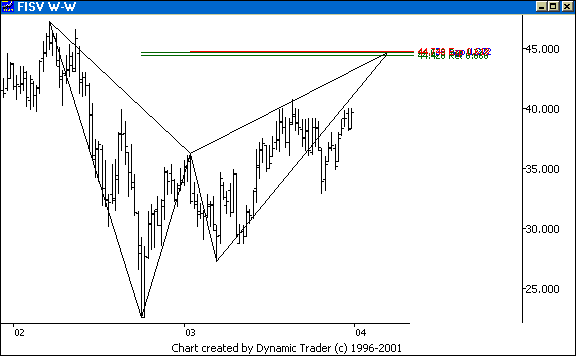|
|
| |
|
 December 23, 2003
Commentary- December 23, 2003
Commentary-
 Once the early morning action was done, the
market slowed to a crawl. The ES was trading at times just 2 or 3 contracts a
minute. Normal can be well over a thousand per minute. At that point I decided
to quit for the day. Even if a nice play ensued, the liquidity risk was just
too great for me. Once the early morning action was done, the
market slowed to a crawl. The ES was trading at times just 2 or 3 contracts a
minute. Normal can be well over a thousand per minute. At that point I decided
to quit for the day. Even if a nice play ensued, the liquidity risk was just
too great for me.
 Today I want to examine something on the FISV play that I presented
in the weekend commentary. This is a perfect example of 'context', and why I
say it is so important. One of my favorite sayings is: "Without context, you
have nothing". Today I want to examine something on the FISV play that I presented
in the weekend commentary. This is a perfect example of 'context', and why I
say it is so important. One of my favorite sayings is: "Without context, you
have nothing".
 Let's take a look again at the daily chart, showing the pattern
that we are looking at. Let's take a look again at the daily chart, showing the pattern
that we are looking at.


 This is a great looking pattern to me, formed
on the daily chart. For me, the traded timeframe here is the daily chart.
Sometimes the pattern I trade will be on the traded timeframe, and sometimes it
will be on the next timeframe up, the 'context' timeframe. This is a great looking pattern to me, formed
on the daily chart. For me, the traded timeframe here is the daily chart.
Sometimes the pattern I trade will be on the traded timeframe, and sometimes it
will be on the next timeframe up, the 'context' timeframe.
 The daily
chart is a very significant timeframe if your trading time span is for days
or a few weeks. If your time horizon is greater, you better be very sure
what the weekly timeframe is showing you. You need to have the context.
Let's look at a weekly chart of FISV, and see if anything stands out. The daily
chart is a very significant timeframe if your trading time span is for days
or a few weeks. If your time horizon is greater, you better be very sure
what the weekly timeframe is showing you. You need to have the context.
Let's look at a weekly chart of FISV, and see if anything stands out.


 First, let me point out something that might
have jumped out at you. First, let me point out something that might
have jumped out at you.


 I don't like
the Fibonacci levels on this pattern as much as I like something else I see,
though. Do you see it? Let me highlight another pattern, and put a grouping on
the chart. I don't like
the Fibonacci levels on this pattern as much as I like something else I see,
though. Do you see it? Let me highlight another pattern, and put a grouping on
the chart.


 I'll now
highlight the pattern that we were looking at Friday, and put an arrow on the
chart pointing to it so that you don't miss it. I'll now
highlight the pattern that we were looking at Friday, and put an arrow on the
chart pointing to it so that you don't miss it.


 Looks a lot different in that light, now doesn't it? A
lot of times a pattern completion point can act like a magnet and seemingly
'draw' the price action to the area. If that happens in this case, the daily
pattern will be 'blown out'. Looks a lot different in that light, now doesn't it? A
lot of times a pattern completion point can act like a magnet and seemingly
'draw' the price action to the area. If that happens in this case, the daily
pattern will be 'blown out'.
 So why did I point out the pattern
on Friday? I was hoping the readers would discover this larger context by
themselves, and start to question me about the significance. I pointed it out
because I knew I was planning on moving on to some context commentary, and
timeframe commentary. So why did I point out the pattern
on Friday? I was hoping the readers would discover this larger context by
themselves, and start to question me about the significance. I pointed it out
because I knew I was planning on moving on to some context commentary, and
timeframe commentary.
 The most popular question that I'm getting
right now is about timeframes. As a response, I'm trying to decide what I can
put together to lay out more detail on how I use timeframes. Keep an eye on the
'What's New' section for
an early glimpse of what I decide to offer. The most popular question that I'm getting
right now is about timeframes. As a response, I'm trying to decide what I can
put together to lay out more detail on how I use timeframes. Keep an eye on the
'What's New' section for
an early glimpse of what I decide to offer.
 This all has
a practical application is my trading. Everyone knows how I keep saying: "If
the area/grouping/pattern holds, that tells me something. And if it doesn't
hold, that also tells me something." Perhaps in this sense I'm unlike most
traders of patterns and the like. I love it when the patterns and groupings
'work'. But I also love it when they fail, because I love to trade failed
areas. Lately I've joked that I might specialize in a few failed pattern
setups. This all has
a practical application is my trading. Everyone knows how I keep saying: "If
the area/grouping/pattern holds, that tells me something. And if it doesn't
hold, that also tells me something." Perhaps in this sense I'm unlike most
traders of patterns and the like. I love it when the patterns and groupings
'work'. But I also love it when they fail, because I love to trade failed
areas. Lately I've joked that I might specialize in a few failed pattern
setups.
 If an area is significant, or perceived to be
significant, then it is also significant if the area doesn't hold. I love to
trade the other side of an area if the area causes a small bounce and then
fails. I am oversimplifying my criteria here, but it's something that makes up
a large part of my trading. There are many ways to take advantage of the
harmonics of a trade. If an area is significant, or perceived to be
significant, then it is also significant if the area doesn't hold. I love to
trade the other side of an area if the area causes a small bounce and then
fails. I am oversimplifying my criteria here, but it's something that makes up
a large part of my trading. There are many ways to take advantage of the
harmonics of a trade.
 I'm pointing this out now, because FISV may
'blow out' this daily pattern in order to complete the weekly pattern. Or the
weekly pattern may not 'work' and get 'blown out'. Keep in mind that the weekly
pattern is set up to reverse FISV's all-time high at an .886 'retest'. Take a
look at charts of the indices and what they are doing and tell me that you want
to make that call. Regardless, though, FISV will point the way for some
potential trading opportunities for me. I'm pointing this out now, because FISV may
'blow out' this daily pattern in order to complete the weekly pattern. Or the
weekly pattern may not 'work' and get 'blown out'. Keep in mind that the weekly
pattern is set up to reverse FISV's all-time high at an .886 'retest'. Take a
look at charts of the indices and what they are doing and tell me that you want
to make that call. Regardless, though, FISV will point the way for some
potential trading opportunities for me.
 Many of the
patterns I have been presenting are ones I have chosen because they are the
most familiar to the readers. But readers who have my books know that I like to
trade the patterns/areas when they are set up to continue the trend,
not reverse it. This is not an easy thing to see on the chart until your
eye really gets trained to see it. Many of the
patterns I have been presenting are ones I have chosen because they are the
most familiar to the readers. But readers who have my books know that I like to
trade the patterns/areas when they are set up to continue the trend,
not reverse it. This is not an easy thing to see on the chart until your
eye really gets trained to see it.
 I cover this extensively in Kane Trading on: Advanced Fibonacci
Trading Concepts and in even greater detail in Kane Trading on: Trading ABCD
Patterns. This is a unique approach that I have seen few, if any, other
traders present. Remember that every 5-point pattern that you have ever seen or
traded is based on an ABCD pattern. All those 5-point patterns are nothing more
than ABCD patterns with certain context added in. And there's that word again,
context. It's not important in my opinion; it's critical. I cover this extensively in Kane Trading on: Advanced Fibonacci
Trading Concepts and in even greater detail in Kane Trading on: Trading ABCD
Patterns. This is a unique approach that I have seen few, if any, other
traders present. Remember that every 5-point pattern that you have ever seen or
traded is based on an ABCD pattern. All those 5-point patterns are nothing more
than ABCD patterns with certain context added in. And there's that word again,
context. It's not important in my opinion; it's critical.
 Given the holiday shortened week and almost zero liquidity, my next
commentary will be the weekend edition, which I plan to have posted well before
the end of the weekend. Given the holiday shortened week and almost zero liquidity, my next
commentary will be the weekend edition, which I plan to have posted well before
the end of the weekend.
 |
|
|
| |
|
|
 NOTE: Reading this page or any page on the Kane
Trading website, or utilizing this website and any material NOTE: Reading this page or any page on the Kane
Trading website, or utilizing this website and any material
contained herein in any way, shall constitute an acknowledgement
that you have read, understood and agreed
to all the
disclaimers,
terms & conditions, and
policies of this site.
 |
|
 This website is best viewed with
MSIE 6.0, text size set to medium, and screen resolution set to 1024 by 768.
This website is best viewed with
MSIE 6.0, text size set to medium, and screen resolution set to 1024 by 768.
 Copyright © 2003 Kane
Trading. All rights reserved. Copyright © 2003 Kane
Trading. All rights reserved.
 |
|


